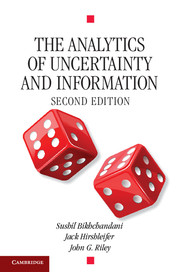3 - Comparative Statics of the Risk-Bearing Optimum
Published online by Cambridge University Press: 05 August 2013
Summary
The elements of the decision problem under uncertainty – the individual's preferences, opportunities, and beliefs – were surveyed in Chapter 1. We distinguished between terminal choices, actions undertaken on the basis of given probability beliefs (covered in Part I of this volume), and informational choices, actions designed to improve one's knowledge of the world before a terminal decision has to be made (to be covered in Part II). Chapter 2 analyzed the individual's risk-bearing optimum, the best terminal action to take in the face of uncertainty.
We now want to explore how these optimizing decisions change in response to variations in the person's character or situation (his or her wealth, tastes for risk, the endowment of goods, the market prices faced, and so forth). Modeling the before-and-after effects of such “parametric” changes, without attending to the dynamics of the actual transition path from one solution to another, is called the method of comparative statics. This chapter is devoted to the comparative statics of the individual's risk-bearing optimum.
Measures of Risk Aversion
The individual’s risk-bearing optimum depends critically upon his attitudes toward risk. And, since parametric changes generally involve positive or negative wealth effects, it will often be crucial to take into account how attitudes toward risk vary as a function of wealth.
Information
- Type
- Chapter
- Information
- The Analytics of Uncertainty and Information , pp. 86 - 122Publisher: Cambridge University PressPrint publication year: 2013
